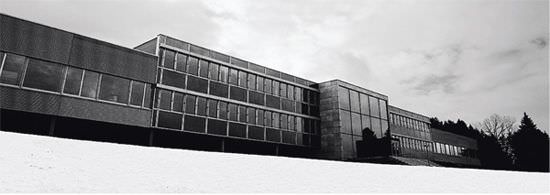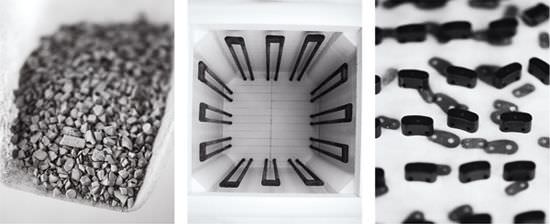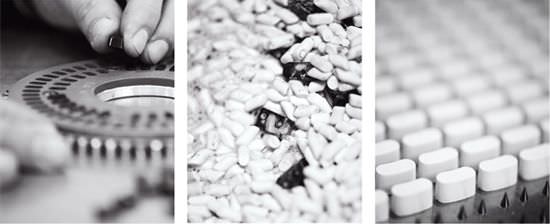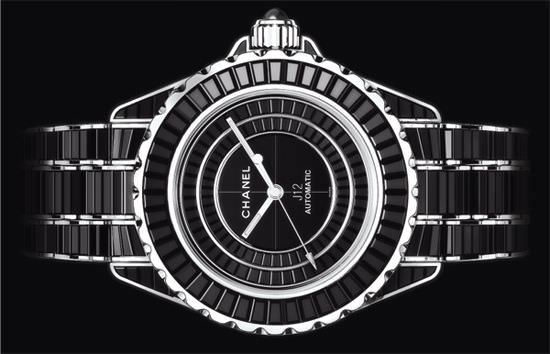G&F Chatelain
The invitation to visit Chanel’s secret ceramic chamber was much awaited especially as it had been guarded like a fortress since its inception. It was no easy place to find however, even with a GPS, as there was no sign of Chanel anywhere, just that of a company called G&F Chatelain. This unassuming building, housing a specialist in case, bracelet and buckle manufacturing, was in fact the home of the Chanel production facilities. G&F Chatelain was founded in 1947 and bought out by Chanel in 1993. The facility didn’t say goodbye to its existing clients, quite the contrary, it continues to make cases, bracelets and buckles for some of the most prestigious brands in Switzerland, which according to its director, Philippe Marty, is a huge advantage “Keeping the autonomy of Chatelain and a variety of customers elevates the level and pushes us to find new techniques of manufacturing and new solutions”. Although, when it comes to ceramic, it’s exclusively Chanel.

Front view of the factory.
A little history
Before we take a peak at how this ceramic is made, let’s take a brief look at the history of the Chanel watch. Chanel’s Creative Director, the late Jacques Helleu, designed the very first Chanel watch, the aptly named Première, for the company in 1987. Three years later, in 2000, Helleu revealed his avant-garde ceramic J12; it was an instant success and has evolved in many artistic and technical directions over the last ten years. 2005 saw the arrival of a J12 fine jewellery collection and a J12 tourbillon. 2006 was marked by a J12 GMT and a haute joaillerie piece with 597 baguette diamonds. In 2008 the company announced a partnership with Audemars Piguet for an automatic movement, the Chanel AP 3125, and this year saw the presentation of the J12 Noir Intense, a ceramic-set timepiece (instead of baguette diamond set) in white gold that caught the eye of all of us at Europa Star. Chanel has created an icon, so much so that other watch brands are quite unashamed in referring to their own ceramic watches as ‘Chanel like’ or ‘Chanel-esque’.
The chamber of secrets
After touring an impressive display of CNC machines within these 8,000 square metre premises, a perfectly ordinary white door with a security code entrance system leads to the chamber of secrets. Inside is an array of unfam-iliar machines carrying out curious operations and three scientists all wearing black protective coats with J12 written on the left breast pocket. This is the secret den of the ceramic workshop where it took six years to find the perfect formula to make watches in this special and very different material. Only three extremely loyal technicians work here as the secret they hold is a very valuable one.
The recipe
Apart from Rado and The Swatch Group, Chanel is the only other company in Switzerland with the technology to make its own ceramic timepieces. Most other ceramic watches on the market are made from blocks of ceramic that are then milled and machined into the right shape, which also works, but doesn’t give the same level of quality as ceramic that is created in the required shape.
The process starts with zirconia powder, a sand-like product that is the source of ceramic. An undisclosed adhesive is then added to the zir-conia to form a sort of dough that is injected into moulds for the J12 case and bracelet links (of which there are nine different link shapes and sizes). Once they have dried, the moulds are placed in a bath to remove the adhesive. What is interesting about this particular adhesive is that it is strong enough to hold the zirconia in place, but also mild enough to be dissolvable in water, avoiding the use of dangerous chemicals. The water is then evaporated away. At this stage the pieces are particularly fragile, somewhat like a sand castle that will crumble at the slightest touch. The hardening of the ceramic takes place in a kiln at 1,000 degrees centigrade – one kiln for the white ceramic and another one for the black ceramic to avoid any of the wrong coloured particles getting into the ceramic.

Pellets of high-tech ceramic in its raw state before firing.- Top view of the kiln in which Chanel fires all its J12 high-tech ceramic components. - Fired black high-tech ceramic links for the J12 just before polishing.

Seating the black high-tech ceramic links for the J12 just before first polishing. - Second polishing stage that will give the J12 links the inalterable shine. - White high-tech ceramic links for the J12 just before assembling.
Shrinking in size
One of the challenges of making ceramic parts is that the heating process shrinks the pieces, so the moulds have to be quite a lot larger at the start. This is a classified mathematical calculation, but to an untrained eye, the moulds looked about 30 percent bigger than the final result. This calculation also has to be applied to the holes that are drilled before going into the kiln as ceramic is like glass and difficult to drill afterwards. Amazingly the final pieces come out to the exact size.
Polishing to perfection
The final stage is the polishing process, which takes place in a big grinding machine where the parts are polished between two grinding stones. As some of the links are on an angle, the grinding stones can also be slanted to create exactly the right shape. Finally the ceramic parts are placed in a tumbling machine together with different materials such as abrasive stones, wood, or even nuts, to polish them to perfection.

J12 NOIR INTENSE
Why has the chamber of secrets been opened?
One of the reasons that Chanel has opened its chamber of secrets is perhaps because the company launched the J12 Noir Intense, a ceramic-set timepiece this spring at a price of Euro 250,000. Not everyone understood the price (including me before the visit!) when the raw materials are ceramic and not baguette diamonds. But ceramic baguettes are even more difficult to set than baguette diamonds. They are extremely hard, like glass, but not hard like diamonds, so one false move and the ceramic cracks or chips. The polishing is equally difficult for the same reasons. There are 724 pieces to be cut. It is a huge undertaking that is painstakingly time consuming. This is probably why Chanel only plans to make five of them.
But the main reason for letting us visit this fascinating workshop was to pass the message about how complicated ceramic is to create. The company is making all its ceramic in-house to the highest possible standard, which is important for the consumer to understand at a time when the ceramic trend is booming and ceramic watches can be found at every level of the horological pyramid. As Philippe Marty puts it, “Who cares? We care, and that makes a luxury product.”
Ceramic has become one of the new precious materials of our era thanks to Chanel and its search for perfect design and the highest quality of fabrication. In a short period of time the company has made its mark on the watch industry by creating a new trend for ceramic timepieces and a style that is instantly recognizable. We can’t wait to see what’s next to come out of the chamber of secrets.
Source: Europa Star August-September 2009 Magazine Issue
































